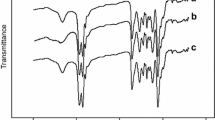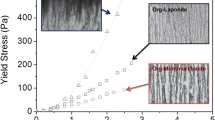Abstract
The destabilization of disperse systems using flocculation is an approach in hydrometallurgy, purification of wastewater, agriculture, etc. The recent efforts here have been made in development of polyelectrolytes. In this work, the bentonite clay hydrodispersions stability under the influence of polyelectrolytes, differing in molar ratio, and types of functionality, was investigated. The dispersions obtained were characterized by spectrophotometry, conductivity measurements, viscometry. The stability of clay hydrodispersions was studied by the turbidimetric method. Under the influence of a polyelectrolyte containing non-ionizable acetate and amide groups, a slight increase in hydrodispersions’ destabilization with the number of very weakly positively charged amide groups was observed. In the presence of polyelectrolytes containing vinyl acetate and well-ionizable aliphatic amine groups, the hydrodispersions’ destabilization was clearly expressed. A pronounced decrease in the hydrodispersion stability was observed under the influence of polyelectrolytes obtained from the highly-ionized 2-vinylpyridine and diethylaminoethylmethacrylate. Polyelectrolytes obtained from vinyl acetate and highly-ionized aliphatic amino-groups had more pronounced effect on destabilization. Hence, features of polyelectrolyte nature, composition, charge density and molecular weight effect on the stability of bentonite clay were elucidated. The selection of the appropriate dose of coagulants and flocculants was demonstrated to be nonlinear function of turbidity.




Similar content being viewed by others
Data availability
The authors confirm that the data supporting the findings of this study are available within the article.
References
Abbaslou H, Hadifard H, Ghanizadeh AR (2020) Effect of cations and anions on flocculation of dispersive clayey soils. Heliyon 6(2):e03462
Amuda OS, Amoo IA (2007) Coagulation/flocculation process and sludge conditioning in beverage industrial wastewater treatment. J Hazard Mater 141(2007):778–783
Asanov, A A. (2010). Mathematic methods of determination of economic, ecological efficiency high molecular weight compounds of soils’ structure formers. Proceedings of the Republic Scientific-Practic Conference “Mathematic Science and Its Contribution into Developing Applied Science Studies”.
Asanov A (2019). Method of obtaining water soluble polyelectrolyte-flocculant. The Republic of Kazakhstan Utility Model Patent 3,961, May 2, 2019.
Asanov, A.A., Bazarxanqizi, A. (2015). Influence of the composition and types of functional groups of water-soluble polymers on the ability to structure the soil. Proceedings of 2nd International Scientific Conference “Theoretical and Applied Sciences in the USA”, 237–246.
Asanov, A.A., Hadjikov, A.P. (2016). The nature of the functional groups, the ratio, the effect of polyelectrolytes on the bentonite hydrodispersion flocculation with different charge characteristics. Proceedings of the 10th International Scientific Conference “European Conference on Innovations inThechnical and Natural Scinces”, 144–152.
Asanov A, Matniyazova GK (2013) Flocculation of industrial water in the presence of carboxide-amide containing polyelectrolytes. World Appl Sci J 25(10):1482–1484
Asanov AA, Nurilina VR, Akhmedov KS (1995) Flocculating effect of water soluble polyelectrolytes based on 2-methyl-5-vinylpyridine metacrylic acid and its amide. Rep Academy Sci Repub Uzbekistan 9–10:29–31
Basga SD, Tsozue D, Temga JP, Balna J, Nguetnkam JP (2018) Land use impact on clay dispersion/flocculation in irrigated and flooded vertisols from Northern Cameroon. Int Soil Water Conserv Res 6(3):237–244
Beluci NDCL, Mateus GAP, Miyashiro CS, Homem NC, Gomes RG, Fagundes-Klen MR, Bergamasco R, Vieira AMS (2019) Hybrid treatment of coagulation/flocculation process followed by ultrafiltration in TiO2-modified membranes to improve the removal of reactive black 5 dye. Sci Total Environ 66:222–229
Bratby J (2016) Coagulation and flocculation in water and wastewater treatment. Water Intell Online. https://doi.org/10.2166/9781780407500
Dotto J, Fagundes-Klen MR, Veit MT, Palácio SM, Bergamasco R (2019) Performance of different coagulants in the coagulation/flocculation process of textile wastewater. J Clean Prod 208:656–665
Draginskii VL, Alekseeva LP, Getmantsev SV (2005). Coagulation in natural water purification technology. Moscow
Gao S, Xiongwei N, Cumming RH, Greated CA, Norman P (1998) Experimental investigation of bentonite flocculation in a batch oscillatory baffled column. Sep Sci Technol 33(14):2143–2157
Getmantsev SV, Nechayev IA, Gandurina LV (2008). Purification of industrial wastewater by coagulants and flocculants. Moscow, 2008, 272 p.
Guibal E, Roussy J (2007) Coagulation and flocculation of dye-containing solutions using a biopolymer (chitosan). React Funct Polym 67:33–42
Hassan MAA, Li TP, Noor ZZ (2009) Coagulation and flocculation treatment of wastewater in textile industry using chitosan. J Ind Eng Chem 4(1):43–53
Katrivesis FK, Karela AD, Papadakis VG, Paraskeva CA (2019) Revisiting of coagulation-flocculation processes in the production of potable water. J Water Process Eng 27:193–204
Konduri MK, Fatehi P (2017) Influence of pH and ionic strength on flocculation of clay suspensions with cationic xylan copolymer. Colloids Surf A 530:20–32
Kuzkin SF, Nebera VP (1963) Synthetic flocculants in dehydration processes. Gostekhizdat, Moscow
Lee KE, Morad N, Teng TT, Poh BT (2012) Development, characterization and the application of hybrid materials in coagulation / flocculation of wastewater: a review. Chem Eng J 203:370–386
Linevich SN, Getmantsev SV (2007) Coagulation method of water treatment. Nauka, Moscow
Luckham PF, Rossi S (1999) The colloidal and rheological properties of bentonite suspensions. Adv J Colloid Interface Sci 82(1–3):43–92
Mardani A, Mohamadnia Z, Kazemi F (2020) Coagulation performance of cationic polyelectrolyte/TiO2 nanocomposites prepared under LED irradiation. J Appl Polym Sci 137(37):49113
Meszaros R, Barany S, Solomentseva I (2010) Effect of hydrodynamic conditions on the kinetics of bentonite suspension flocculation by cationic polyelectrolytes and the strength of formed flocs. Colloid J 72(3):409–416
Momeni MM, Kahforoushan D, Abbasi F, Ghanbarian S (2018) Using Chitosan/CHPATC as coagulant to remove color and turbidity of industrial wastewater: optimization through RSM design. J Environ Manage 211:347–355
Mortadi A, Chahid EG, Nasrellah H, Cherkaoui O, El Moznine R (2019) Dielectric and electric properties as a tool to investigate the coagulation mechanism during sludge treatment. Environ Technol 40(1):72–85
Mortadi A, Chahid EG, Elmelouky A, Chahbi M, Ghyati NE, Zaim S, Cherkaoui O, El Moznine R (2020) Complex electrical conductivity as a new technique to monitor the coagulation-flocculation processes in the wastewater treatment of the textile industry. Water Resour Ind 24:100130
Myagchenkov VA, Kurenkov VF (1991) Applications of acrylamide polymers and copolymers: a review. Polym-Plast Technol Eng 30(2–3):109–135
Myagchenkov VA, Proskurina VE (2000) Synergism of ionic acrylamide copolymers and electrolyte (NaCl) in ocher flocculation in unhindered sedimentation mode. Russ J Appl Chem 73(6):1070–1073
Myagchenkov V, Proskurina V, Polushina A, Gabdullina L (2010) Kinetic aspects of flocculation of bentonite clay in the presence of anionic and cationic acrylamide copolymers. Russ J Appl Chem 83(5):878–884
Owen AT, Fawell PD, Swift JD (2007) The preparation and ageing of acrylamide/acrylate copolymer flocculant solutions. Int J Miner Process 84(1–4):3–14
Proskurina VE, Churikov FI, Myagchenkov VA (2002) Kinetics of ochre suspension sedimentation in the presence of anionic and cationic co-polymers of acrylamide and their mixtures. Russian J Chem Chem Technol 45(2):26–30
Rajala K, Grönfors O, Hesampour M, Mikola A (2020) Removal of microplastics from secondary wastewater treatment plant effluent by coagulation/flocculation with iron, aluminum and polyamine-based chemicals. Water Res 183:116045
Shaikh SM, Nasser MS, Hussein I, Benamor A, Onaizi SA, Qiblawey H (2017a) Influence of polyelectrolytes and other polymer complexes on the flocculation and rheological behaviors of clay minerals: a comprehensive review. Sep Purif Technol 187:137–161
Shaikh SM, Nasser MS, Hussein IA, Benamor A (2017b) Investigation of the effect of polyelectrolyte structure and type on the electrokinetics and flocculation behavior of bentonite dispersions. Chem Eng J 311:265–276
Shaikh SM, Nasser MS, Magzoub M, Benamor A, Hussein IA, El-Naas MH, Qiblawey H (2018) Effect of electrolytes on electrokinetics and flocculation behavior of bentonite-polyacrylamide dispersions. Appl Clay Sci 158:46–54
Torres NH, Souza BS, Ferreira LFR, Lima ÁS, dos Santos GN, Cavalcanti EB (2019) Real textile effluents treatment using coagulation/flocculation followed by electrochemical oxidation process and ecotoxicological assessment. Chemosphere 236:124309
Tripathy T, De BR (2006) Flocculation: a new way to treat the waste water. J Phys Ther Sci 10:93–127
Veréb G, Gayır VE, Santos EN, Fazekas Á, Kertész S, Hodúr C, László Z (2019) Purification of real car wash wastewater with complex coagulation/flocculation methods using polyaluminum chloride, polyelectrolyte, clay mineral and cationic surfactant. Water Sci Technol 80(10):1902–1909
Wang K, Wei T, Li Y, He L, Lv Y, Chen L, Ahmad A, Xu Y, Shi Y (2020) Flocculation-to-adsorption transition of novel salt-responsive polyelectrolyte for recycling of highly polluted saline textile effluents. Chem Eng J. https://doi.org/10.1016/j.cej.2020.127410
Wilkinson N, Metaxas A, Quinney C, Wickramaratne S, Reineke TM, Dutcher CS (2018) pH dependence of bentonite aggregate size and morphology on polymer-clay flocculation. Colloids Surf A 537:281–286
Yousefi SA, Nasser MS, Hussein IA, Benamor A, El-Naas MH (2020) Influence of polyelectrolyte structure and type on the degree of flocculation and rheological behavior of industrial MBR sludge. Sep Purif Technol 233:116001
Zafisah NS, Ang WL, Mohammad A, Hilal N, Johnson DJ (2020) Interaction between ballasting agent and flocs in ballasted flocculation for the removal of suspended solids in water. J Water Process Eng 33:101028
Zhang H, Yang L, Zang X, Cheng S, Zhang X (2019) Effect of shear rate on floc characteristics and concentration factors for the harvesting of Chlorella vulgaris using coagulation-flocculation-sedimentation. Sci Total Environ 688:811–817
Funding
No funding was received.
Author information
Authors and Affiliations
Corresponding author
Ethics declarations
Conflict of interest
The authors declare that they have no conflict of interest.
Ethical approval
This chapter does not contain any studies with human participants or animals performed by any of the authors.
Additional information
Publisher's Note
Springer Nature remains neutral with regard to jurisdictional claims in published maps and institutional affiliations.
Rights and permissions
About this article
Cite this article
Asanov, A., Mameshova, S. Influence of functional polyelectrolytes on the stability of clay hydrodispersions. Chem. Pap. 75, 5695–5703 (2021). https://doi.org/10.1007/s11696-021-01718-4
Received:
Accepted:
Published:
Issue Date:
DOI: https://doi.org/10.1007/s11696-021-01718-4




